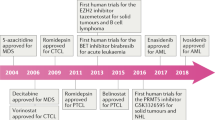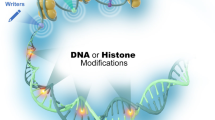Opinion statement
Epigenetic mutations are frequent and pathogenic in select subtypes of lymphoma, and agents modulating DNA and histone methylation—such as inhibitors of DNMT and EZH2, respectively—have demonstrated promise in treating these diseases. In particular, lymphomas derived from the germinal center—GC-DLBCL, FL, and AITL—are all characterized by epigenetic derangements. In an effort to target these derangements, DNMT inhibitors have been investigated as a means of improving responsiveness to chemotherapy in DLBCL patients, or as monotherapy or in combination with other epigenetic agents in the treatment of TCL. Histone methyltransferase inhibitors have demonstrated effectiveness in R/R FL patients with EZH2-activating mutations. New treatment options that target the pathogenesis of disease are needed. HDAC inhibitors have been in the clinic for over a decade for the treatment of lymphoma, and now methyltransferase inhibitors are finding their niche for this disease.

Similar content being viewed by others
References and Recommended Reading
Papers of particular interest, published recently, have been highlighted as: • Of importance •• Of major importance
Clozel T, Yang S, Elstrom RL, Tam W, Martin P, Kormaksson M, et al. Mechanism-based epigenetic chemosensitization therapy of diffuse large B-cell lymphoma. Cancer Discov. 2013;3(9):1002–19. https://doi.org/10.1158/2159-8290.CD-13-0117.
Zhang M, Xu P, Cheng S, Wang L, Zhao W. Decitabine plus R-CHOP in patients with newly diagnosed diffuse large B-cell lymphoma: interim results of a phase I/II study. Hematol Oncol. 2019;37(S2):528.
Mak V, Hamm J, Chhanabhai M, Shenkier T, Klasa R, Sehn LH, et al. Survival of patients with peripheral T-cell lymphoma after first relapse or progression: spectrum of disease and rare long-term survivors. J Clin Oncol. 2013;31(16):1970–6. https://doi.org/10.1200/JCO.2012.44.7524.
Gallipoli P, Huntly BJP. Novel epigenetic therapies in hematological malignancies: current status and beyond. Semin Cancer Biol. 2018;51:198–210. https://doi.org/10.1016/j.semcancer.2017.07.005.
Pera B, Tang T, Marullo R, Yang SN, Ahn H, Patel J, et al. Combinatorial epigenetic therapy in diffuse large B cell lymphoma pre-clinical models and patients. Clin Epigenetics. 2016;8:79. https://doi.org/10.1186/s13148-016-0245-y.
Jiang Y, Melnick A. The epigenetic basis of diffuse large B-cell lymphoma. Semin Hematol. 2015;52(2):86–96. https://doi.org/10.1053/j.seminhematol.2015.01.003.
Whittaker S. Global patterns of methylation in sezary syndrome provide insight into the role of epigenetics in cutaneous T-cell lymphoma. J Invest Dermatol. 2016;136(9):1753–4. https://doi.org/10.1016/j.jid.2016.05.114.
Ma H, Davarifar A, Amengual JE. The future of combinatorial therapies for peripheral T-cell lymphoma (PTCL). Curr Hematol Malig Rep. 2018;13(1):13–24. https://doi.org/10.1007/s11899-018-0432-3.
Dimopoulos K, Gronbaek K. Epigenetic therapy in hematological cancers. APMIS. 2019;127(5):316–28. https://doi.org/10.1111/apm.12906.
Swerdlow SH, Campo E, Harris NL, Jaffe ES, Pileri SA, et al. WHO classification of tumours of haematopoietic and lymphoid tissues. Lyon (France): International Agency for Research on Cancer; 2017.
Lue JK, Amengual JE. Emerging EZH2 inhibitors and their application in lymphoma. Curr Hematol Malig Rep. 2018;13(5):369–82. https://doi.org/10.1007/s11899-018-0466-6.
Schmitz R, Wright GW, Huang DW, Johnson CA, Phelan JD, Wang JQ, et al. Genetics and pathogenesis of diffuse large B-cell lymphoma. N Engl J Med. 2018;378(15):1396–407. https://doi.org/10.1056/NEJMoa1801445.
Szablewski V, Bret C, Kassambara A, Devin J, Cartron G, et al. An epigenetic regulator-related score (EpiScore) predicts survival in patients with diffuse large B cell lymphoma and identifies patients who may benefit from epigenetic therapy. Oncotarget. 2018;9(27):19079–99. https://doi.org/10.18632/oncotarget.24901.
Moskowitz AJ. Practical treatment approach for angioimmunoblastic T-cell lymphoma. J Oncol Pract. 2019;15(3):137–43. https://doi.org/10.1200/JOP.18.00511.
Dominguez PM, Ghamlouch H, Rosikiewicz W, Kumar P, Béguelin W, Fontan L, et al. TET2 deficiency causes germinal center hyperplasia, impairs plasma cell differentiation and promotes B-cell lymphomagenesis. Cancer Discov. 2018;8(12):1632–53. https://doi.org/10.1158/2159-8290.CD-18-0657.
Cairns RA, Iqbal J, Lemonnier F, Kucuk C, de Leval L, Jais J-P, et al. IDH2 mutations are frequent in angioimmunoblastic T-cell lymphoma. Blood. 2012;119(8):1901–3. https://doi.org/10.1182/blood-2011-11-391748.
Martin P, Bartlett NL, Rivera IIR, Revuelta M, Chavez JC, et al. A phase I, open-label, multicenter trial of oral azacitidine (cc-486) plus R-CHOP in patients with high-risk, previously untreated diffuse large B cell lymphoma, grade 3B follicular lymphoma or transformed lymphoma. Blood. 2017;130(1):192.
•• Morschhauser F, Tilly H, Chaidos A, Phillips T, Ribrag V, et al. Interim Update from a phase 2 multicenter study of tazemetostat, an EZH2 inhibitor, in patients with relapsed or refractory follicular lymphoma. Hematol Oncol. 2019;37(S2):154–6. https://doi.org/10.1002/hon.111_2629 Clinical trial demonstrating the efficacy of the EZH2 inhibitor tazemetostat in FL patients with EZH2 mutations.
Morin RD, Johnson NA, Severson TM, Mungall AJ, An J, Goya R, et al. Somatic mutations altering EZH2 (Tyr641) in follicular and diffuse large B-cell lymphomas of germinal-center origin. Nat Genet. 2010;42(2):181–5. https://doi.org/10.1038/ng.518.
Blakemore SJ, Daigle SR, McDonald AA, Morschhauser F, Ribrag V, et al. Preliminary evidence of a molecular predictor of tazemetostat response, beyond EZH2 mutation, in NHL patients via characterization of archive tumor and circulating tumor DNA. Hematol Oncol. 2017;35(S2):159–60. https://doi.org/10.1002/hon.2438_14.
•• Delarue R, Dupuis J, Sujobert P, Barbieux S, Marcais A, et al. Treatment with hypomethylating agent 5-Azacytidine induces sustained response in angioimmunoblastic T-cell lymphomas. Blood. 2016;128:4164 First clinical trial demonstrating the efficacy of a DNMT inhibitor in TCL.
• Falchi L, Lue JK, Montanari F, Marchi E, Amengual JE, et al. Targeting the peripheral T-cell lymphoma (PTCL) epigenome with oral 5-azacytadine and romidepsin: results and clinical-molecular correlations from a phase 2 study. Hematol Oncol. 2019;37(S2):178–9. https://doi.org/10.1002/hon.135_2629 Clinical trial utilizing combination therapy with a DNMT inhibitor and an HDAC inhibitor in TCL.
Gregory GP, Dickinson M, Yannakou CK, Wong J, Blombery P, Corboy G, et al. Rapid and durable complete remission of refractory AITL with azacitidine treatment in absence of TET2 mutation or concurrent MDS. HemaSphere. 2019;3(2):e187. https://doi.org/10.1097/HS9.0000000000000187.
Maruyama D, Tobinai K, Makita S, Ishida T, Kusumoto S, et al. First-in-human study of the EZH1/2 dual inhibitor DS-3201b in patients with relapsed or refractory non-Hodgkin lymphoma. Blood. 2017;130(S1):4070.
Author information
Authors and Affiliations
Corresponding author
Ethics declarations
Conflict of Interest
Jacob C. Cogan declares that he has no conflict of interest.
Yuxuan Liu declares that she has no conflict of interest.
Jennifer E. Amengual has received research funding from Appia Pharmaceuticals and has a patent (US201461972571P) issued and licensed; however, neither relate to this article.
Human and Animal Rights and Informed Consent
This article does not contain any studies with human or animal subjects performed by any of the authors.
Additional information
Publisher’s note
Springer Nature remains neutral with regard to jurisdictional claims in published maps and institutional affiliations.
This article is part of the topical collection on Lymphoma
Rights and permissions
About this article
Cite this article
Cogan, J.C., Liu, Y. & Amengual, J.E. Hypomethylating Agents in Lymphoma. Curr. Treat. Options in Oncol. 21, 61 (2020). https://doi.org/10.1007/s11864-020-00761-9
Published:
DOI: https://doi.org/10.1007/s11864-020-00761-9




